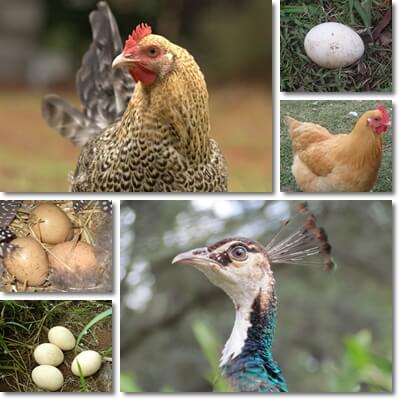The peahen is the female bird of the peafowl species, a pheasant-like bird known for its attractive plumage with iridescent or metallic green, blue, gold or copper colors. The hen is the female bird of the domestic chicken and related to the peahen. Both birds lay edible eggs, fitted for human consumption. Chicken eggs are the eggs we compare all other eggs to and, in a manner, the preferred variety. However, other varieties are slowly starting to gain popularity, as more and more people are learning to appreciate the different flavors of different eggs. One such variety is peahen eggs. And the number one question on people’s minds when they first lay their eyes on the new egg variety is: how are peahen eggs different from chicken eggs in terms of appearance, taste and nutritional value?
What is the difference between peahen and chicken eggs?
Peahen and chicken eggs are very similar, yet not quite the same. In terms of appearance and taste, the following differences can be noted:
1) Peahen eggs are bigger, usually at least two times the size of a large chicken egg (estimated at 50 g), or slightly bigger. Some put the average peahen egg at 110 g. Younger peahens may lay smaller eggs.
2) The egg yolk is also bigger in peahen eggs than in chicken eggs which is to be expected since the eggs themselves are bigger. There is also slightly more yolk compared to egg white in peahen eggs than in chicken eggs.

3) Peahen eggs are an off white or milky white for the most part. But they can also be a pale pink, light, pale yellow or yellowish brown to a moderate reddish brown. Chicken eggs come in all colors and color tones, from white to cream with yellow or pink undertones to light blue, sage green, light brown, reddish brown, brown, chocolate and olive green. They can be speckled, spotted or discolored.
4) The eggshell of peahen eggs is thicker than the eggshell of chickens’ and requires a little more effort when breaking open the eggs for cooking.
5) Peahen eggs taste similar to chicken eggs, but have a slightly richer flavor due to the higher yolk to egg white ratio, with a faint gamy aftertaste and a delicate sweetness to the yolk. However, some people report not noticing any difference in taste between peahen and chicken eggs.
The birds’ diets play a vital part in how the eggs will taste. A diet as close as possible to the birds’ natural diet will result in the best tasting eggs. For this, peahens should be allowed to forage and receive a feed slightly higher in protein. Chicken should also be allowed to forage, eat insects, small reptiles, seeds, flowers and receive adequate feed. The more natural and nutritious the diet, the better the taste and nutrition of the eggs. Also, free range eggs will have a darker colored yellow-orange yolk and more antioxidant pigments.

Peahen vs chicken eggs nutrition
Peahen and chicken eggs generally have a very similar nutritional value, provided both the birds enjoy similar diets, preferably allowed to forage and given proper, quality feed to complete their diets and meet all of their nutritional requirements. Provided they enjoy roughly the same diets, the only major difference between these eggs is their size. And more egg of any kind essentially means more nutrients of all kinds, from protein and fat, cholesterol and Omega-3 fatty acids to B vitamins and dietary minerals like potassium, phosphorus and zinc. And because peahen eggs are typically two times the size of a large domestic chicken egg, or slightly bigger, they will provide more nutrients in general per egg.
One peahen egg is the equivalent of about two large chicken eggs at 50 g each. So instead of eating two large chicken eggs, you can eat one peahen egg and get about the same nutrition (provided the birds eat similar diets). If we were to compare the two varieties, the major nutritional differences would be as follows:
1) Studies on blue peafowl eggs show that 100 g of blue peafowl egg provides slightly less fat than 100 g of chicken egg. At the same time, one peahen egg will provide more fat overall compared to one chicken egg, because of its size and because the yolk is bigger than that of chicken eggs. And since virtually all the fat is in the yolk, eating more yolk provides more fat overall.
2) One peahen egg may provide slightly more Omega-3 fatty acids than one chicken egg as a result of the bigger yolk and the bird’s natural diet providing better nutrition overall. Peahens eat plants, seeds, flower petals and grass as well as insects, small reptiles or amphibians. Omega-3 fatty acids provide benefits for the brain and cardiovascular system. Studies show Omega-3 is physically present in the brain and in significant amounts and provides benefits for brain health and vision. Chicken eggs that are not free range are expected to contain very little Omega-3 fatty acids in general.
3) More cholesterol in one peahen egg yolk than in one chicken egg yolk, but 100 g of peahen egg contains about the same amount of cholesterol as 100 g of chicken egg. The reason is the peahen yolk is larger. And even if we were to eat one whole peahen egg (average weight estimated at 110 g) instead of two regular size chicken eggs (weight estimated at 44 g an egg) or two small ones (weight estimated at 38 g an egg) and get more cholesterol, it could still be a good thing. This is because cholesterol is an essential nutrient, meaning we need it to be healthy. It’s physically present in our brain and helps make up the protective coating surrounding the tail of nerve cells (called a myelin sheath).
If this protective coating deteriorates, it exposes nerve cells and affects the transmission of electrical impulses. And this could mean a higher risk for degenerative diseases of the nervous system like multiple sclerosis. So a little bit more cholesterol sometimes is a good thing (unless you have medical conditions that require you to eat less fat). See article on Cholesterol: Good or Bad for Your Health?
4) More protein in peahen eggs. And not just because they are bigger. Studies on blue peahen eggs vs chicken eggs show peahen eggs provide more protein overall than chicken eggs and even more protein than quail, duck and even ostrich eggs studied (study: Comparison of Quality and Nutritional Components of Eggs from Blue Peafowl and Hen).
Of the essential amino acids (that the human body cannot synthesize but requires for good health), valine, lysine, leucine and isoleucine were found to be in greater amount in peahen eggs. Tyrosine (conditionally essential amino acid) and alanine (non-essential) were also better represented in peahen eggs. In this respect, they are actually healthier and better for you (read more about the properties and benefits of peahen and other egg varieties).
5) More zinc, manganese and calcium in peahen eggs. This means choosing peahen over chicken contributes to better immunity, antioxidant protection and more benefits for bones and teeth. Research shows blue peahen eggs may contain up to 7 times more zinc than chicken eggs. There is also more vitamin B1 and B2 in peahen eggs as well as more sodium and selenium (important for thyroid health).
At the same time, chicken eggs were found to contain more iron, potassium and copper and are thus better for anemia and fatigue, blood pressure as well as provide good antioxidant benefits. They also contain more of vitamins A and E compared to peahen eggs.
While there is still more research to be conducted, hopefully this information will serve as a guide when looking to better understand the nutrition of peahen eggs compared to chicken eggs.
